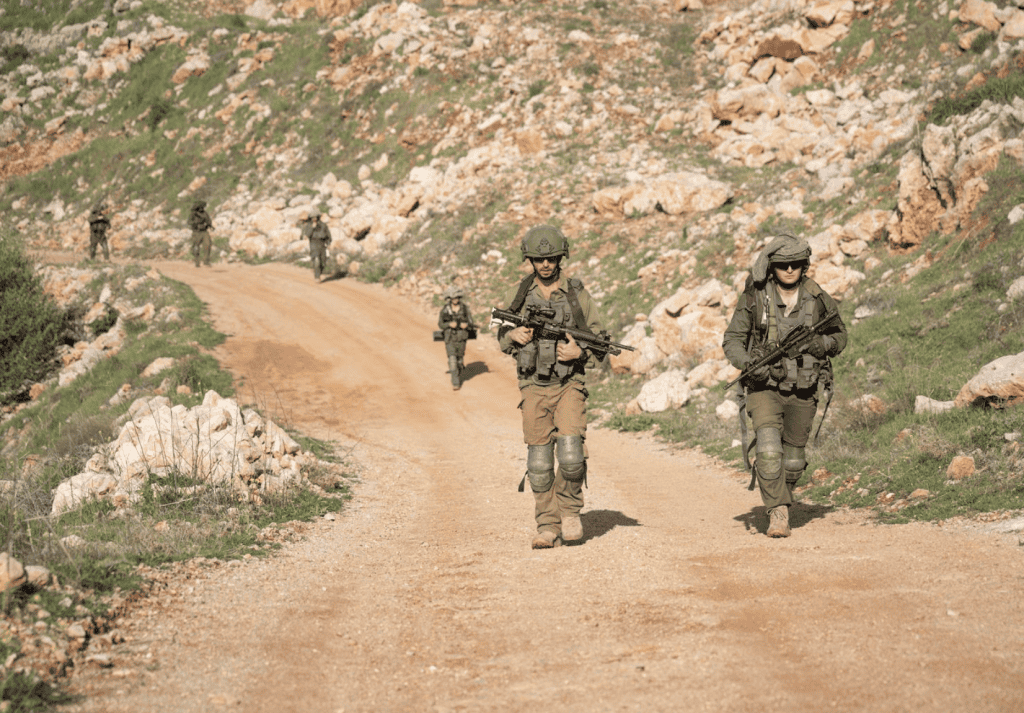
IDF soldiers patrolling a dirt road near the northern border of Israel. (IDF)
Hezbollah targeted Israel with a series of attacks over the Passover holiday which began in Israel at sunset on April 22. Attacks from Lebanon began around sunset at seven in the evening when sirens sounded near Safed in northern Israel and along the northern border. The attacks in Israel continued in the morning and afternoon on April 23. The Israel Defense Forces said that air defenses intercepted drones in northern Israel.
Explosions could be heard from beaches north of Haifa along Haifa Bay. This area is around 20 miles south of the Lebanese border, which is visible along a row of hills far in the distance on a clear day. On the morning of April 23, the IDF said that it had targeted Hussein Ali Azkul, “a significant terrorist operative in Hezbollah’s Aerial Defense Unit in southern Lebanon.” He was killed in an airstrike, the IDF said. “Azkul was heavily involved in the planning and execution of terrorist attacks against Israel and was involved in the Hezbollah’s Aerial unit’s routine activities. His elimination significantly harms the capabilities of Hezbollah’s Aerial Unit.” Hezbollah also announced the death of Mohammad Khalil Atiyeh, a commander in the terror group’s elite Radwan unit.
Hezbollah has been attacking Israel almost daily since October 8, 2023 when it began attacking in support of the Hamas attack on Israel the day before. Over six months, it has fired around 3,200 rockets, drones and missiles at Israel. Over the first weeks of April, it has increased its attempts to target IDF military facilities. Hezbollah has said it targeted a headquarters of the IDF’s 91st division, a brigade command site, and an Iron Dome site. Hezbollah also wounded 14 soldiers in an attack on Arab al-Aramshe, an Arab village in Israel that sits on the northern border.
Hezbollah often takes responsibility for its attacks and explains them in the context of a tit-for-tat conflict that has been ongoing for six months. As such, Hezbollah often strikes more deeply into Israel when it claims to be responding to certain types of Israeli strikes, and Israel often does the same in response, creating a cycle of escalation and de-escalation. April 23 represented an escalation.
On April 23, apparently in response to the IDF strike on Atiyeh, Hezbollah launched drones toward northern Israel. Sirens sounded south of the city of Nahariyah at 13:41. “Following the sirens that sounded in northern Israel regarding a hostile aircraft infiltration, a short while ago, the IDF Aerial Defense Array successfully intercepted a suspicious aerial target off the coast of Nahariyya,” the IDF said.
Several minutes later, FDD’s Long War Journal confirmed an air defense interceptor launched over the bay of Haifa, near the city of Acre. Sirens sounded around the same time at 13:47. An explosion occurred over the water and a quarter of a million residents of the nearby suburbs of Haifa were sent to shelters.
Hezbollah has generally refrained from targeting the city of Nahariya or Haifa, or the areas between them along the coast. However, the threats have increased in recent months and the IDF has been conducting training with several IDF divisions to coordinate between the army, air force, navy, and local authorities and police.
Several smaller attacks at northern Israeli communities continued throughout the afternoon, including in Margaliot, Baram, Zarit and Shomera — all areas close to the border. The IDF said that it struck “two military structures in which Hezbollah terrorists were operating in the areas of Ayta ash Shab and Blida. Additionally, fighter jets struck additional military structures in the area of Markaba in southern Lebanon.”







